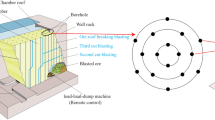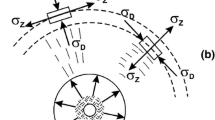Abstract
In open-pit mining, blasting pattern design is performed to achieve a desired degree of fragmentation for loading, hauling, and crushing operations. Inappropriate fragmentation of rock will result in numerous problems such as incurring extra costs for secondary blasting, production interruption, etc. Wetness of the blast holes is one of the most important factors, which can cause the inappropriate rock fragmentation. Lowering ambient temperature in the vicinity of the explosion, the presence of water in the hole adversely affects the quality of the explosive while dissipating part of the explosion energy, ending up with inappropriate fragmentation problems. In the present research, in order to study blast-induced fragmentation conditions in Baba-Ali Iron Ore Mine, three scenarios were considered: explosion of ammonium nitrate with fuel oil (ANFO) in dry hole, explosion of ANFO in wet hole, and explosion of the emulsion in wet hole. For this purpose LS-DYNA, a numerical simulation code was used. Results of the present research showed that, compared to the explosion of ANFO in wet hole, the explosion of the emulsion produced more uniform distribution of fragment size, while the explosion of ANFO in dry hole resulted in fewer large fragments.















Similar content being viewed by others
References
Jimeno CL, Jimeno EL, Carcedo FJA. Drilling and blasting of rocks. Rotterdam: Balkema; 1995
Ebrahimi E, Monjezi M, Khalesi MR, Jahed AD (2016) Prediction and optimization of back-break and rock fragmentation using an artificial neural network and a bee colony algorithm. Bull Eng Geol Environ 75:27–36
Shams S, Monjezi M, Johari Majd V, Jahed AD (2015) Application of fuzzy inference system for prediction of rock fragmentation induced by blasting. Arab J Geosci 8:10819–10832
Hasanipanah M, Jahed Armaghani D, Monjezi M, Shams S (2016) Risk assessment and prediction of rock fragmentation produced by blasting operation: a rock engineering system. Environ Earth Sci 75:808
Hasanipanah M, Bakhshandeh Amnieh H, Saber Zamzam M, Arab H (2018) Feasibility of PSO–ANFIS model to estimate rock fragmentation produced by mine blasting. Neural Comput & Applic 30:1015–1024
Singh PK, Roy MP, Paswan RK (2016) Sarim, Kumar S, Ranjan Jha R. rock fragmentation control in opencast blasting. J Rock Mech Geotech Eng 8:225–237
Trivedi R, Singh TN, Raina AK (2016) Simultaneous prediction of blast-induced flyrock and fragmentation in opencast limestone mines using back propagation neural network. Int. J. Mining and Mineral Engineering 7:237–252
Bakhtavar E, Khoshrou H, Badroddin M (2015) Using dimensional-regression analysis to predict the mean particle size of fragmentation by blasting at the Sungun copper mine. Arab J Geosci 8:2111–2120
Mehrdanesh A, Monjezi M, Sayadi AR (2018) Evaluation of effect of rock mass properties on fragmentation using robust techniques. Eng Comput 34:253–260
Murlidhar BR, Jahed Armaghani D, Tonnizam Mohamad E, Changthan S (2018) Rock fragmentation prediction through a new hybrid model based on Imperial competitive algorithm and neural network. Smart Construction Research 2:1–12
Faraji Asl P, Monjezi M, Khademi Hamidi H, Jahed AD (2018) Optimization of flyrock and rock fragmentation in the Tajareh limestone mine using metaheuristics method of firefly algorithm. Eng Comput 34:241–251
Prasad S, Choudhary BS, Mishra AK (2017) Effect of stemming to burden ratio and powder factor on blast induced rock fragmentation– a case study. IOP Conf Series: Materials Science and Engineering 225:012191
Ghaeini N, Mousakhani M, Bakhshandeh Amnieh H, Jafari A (2017) Prediction of blasting fragmentation using the mutual information and rock engineering system; case study: Meydook copper mine. International Journal of Mining and Geo-Engineering 51:23–28
Monjezi M, Rezaei M, Yazdian VA (2009) Prediction of rock fragmentation due to blasting in Gol-E-Gohar iron mine using fuzzy logic. Int J Rock Mech Min Sci 46:1273–1280
Bahrami A, Monjezi M, Goshtasbi K, Ghazvinian A (2011) Prediction of rock fragmentation due to blasting using artificial neural network. Eng Comput 27:177–181
Sayadi A, Monjezi M, Talebi N, Khandelwal M (2013) A comparative study on the application of various artificial neural networks to simultaneous prediction of rock fragmentation and backbreak. J Rock Mech Geotech Eng 5(4):318–324
Karami A, Afiuni-Zadeh S (2013) Sizing of rock fragmentation modeling due to bench blasting using adaptive neuro-fuzzy inference system (ANFIS). Int J Min Sci Technol 23(6):809–813
Mahadevan EG. Ammonium nitrate explosives for civil applications slurries, emulsions and ammonium nitrate fuel oils. Wiley-VCH Verlag & Co. KGaA, Boschstr. 12, 69469 Weinheim, Germany; 2013
Dehghani H, Shafaghi M (2017 Jan 1) Prediction of blast-induced flyrock using differential evolution algorithm. Eng Comput 33(1):149–158
Riedel W, Thoma K, Hiermaier S, Schmolinske E. Penetration of reinforced concrete by BETA-B-500, numerical analysis using a new macroscopic concrete model for hydrocodes. In: Proceedings of the 9th International Symposium on Interaction of the Effects of Munitions with Structures. Berlin; 3–7 May 1999;315–322
Yi C, Sjoberg J, Johansson D, Petropoulos N (2017) A numerical study of the impact of short delays on rock fragmentation. Int J Rock Mech Min Sci 100:250–254
Schill M. Finite element simulations of blasting and the effects of precise initiation on fragmentation. Swebrec Report, No 2012:2; ISSN 1653-5006
Haimson B, Chang C (2000) A new true triaxial cell for testing mechanical properties of rock, and its use to determine rock strength and deformability of westerly granite. Int J Rock Mech Min Sci 37:285–296
Shah QH (2011) Experimental and numerical study on the orthogonal and oblique impact on water filled pipes. International Journal of Impact Engineering 38:330–338
Panciroli R, Abrate S, Minak G, Zucchelli A (2012) Hydroelasticity in water-entry problems: comparison between experimental and SPH results. Compos Struct 94:532–539
Hansson H. Determination of properties for emulsion explosives using cylinder expansion tests and numerical simulation. Swebrec report. No: 2009:1 ISSN 1653–5006
Author information
Authors and Affiliations
Corresponding author
Ethics declarations
Conflict of Interest
On behalf of all authors, the corresponding author states that there is no conflict of interest.
Additional information
Publisher’s Note
Springer Nature remains neutral with regard to jurisdictional claims in published maps and institutional affiliations.
Rights and permissions
About this article
Cite this article
Dehghani, H., Babanouri, N., Alimohammadnia, F. et al. Blast-Induced Rock Fragmentation in Wet Holes. Mining, Metallurgy & Exploration 37, 743–752 (2020). https://doi.org/10.1007/s42461-019-00163-y
Received:
Accepted:
Published:
Issue Date:
DOI: https://doi.org/10.1007/s42461-019-00163-y




